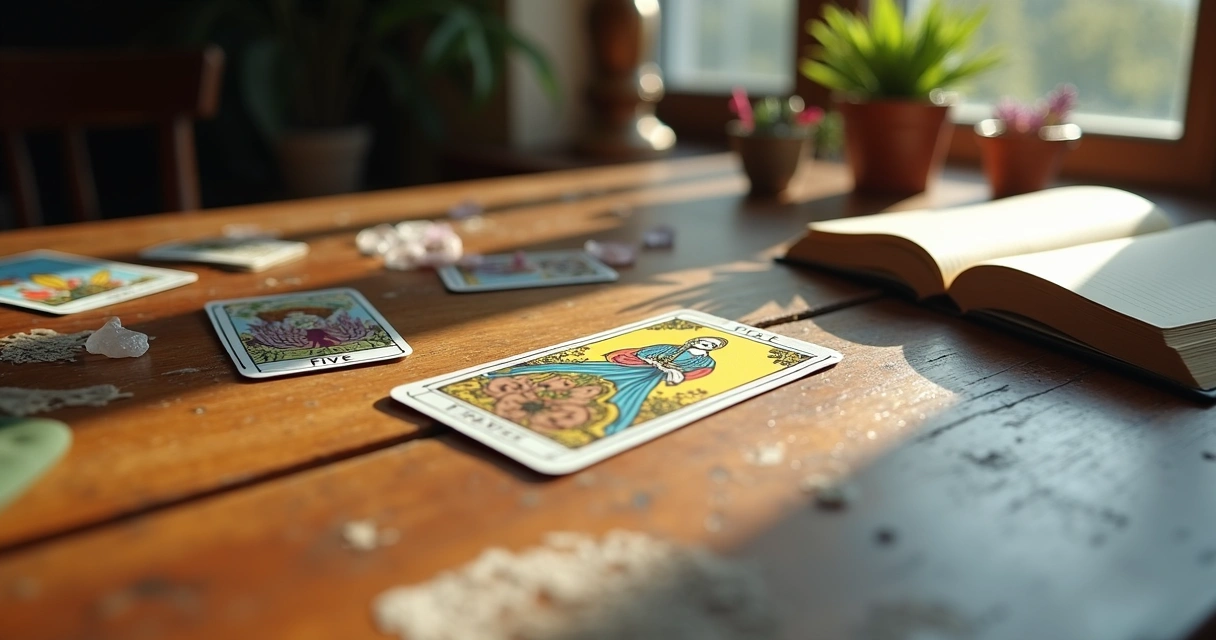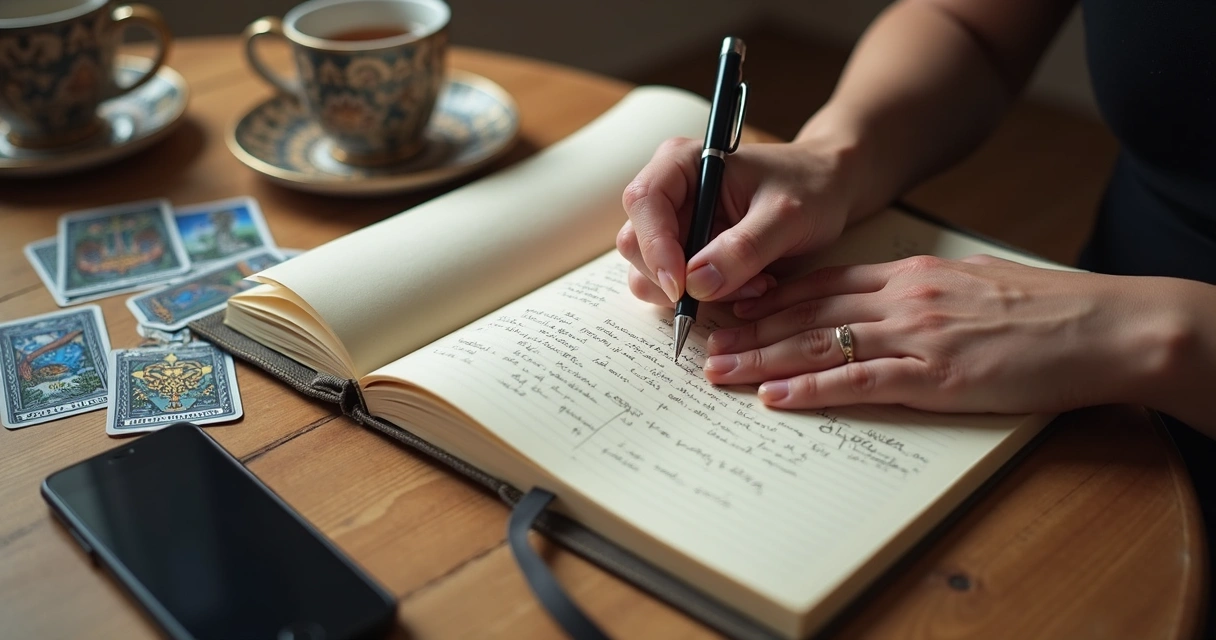Reading tarot, we often encounter cards that unsettle, cards that prick at deeper questions than the surface brings. The Five of Wands, with its chaotic energy and muddled action, is one of those. When we pull this card for ourselves or a querent, it’s like catching the heat of a debate mid-sentence. Yet, as we’ve seen using MysticLog for our own readings and teaching, this energy has its place. Let’s take a closer look at what the Five of Wands reveals, how to work with it, and why keeping track of such patterns matters for growth.
 Understanding the Five of Wands
Understanding the Five of Wands
We find Five of Wands in the Minor Arcana, belonging to the suit of Wands which reflects passion, motivation, and willpower. In artwork, we usually see five individuals waving their wands, each moving in their own direction, sometimes clashing, sometimes only just missing one another. It’s not a full fight; more a spark of disagreement.
The Five of Wands reflects conflict—sometimes chaotic, sometimes creative—but always carrying the opportunity for learning.
But what does this really mean in a tarot reading? Essentially, when this card appears, it signals competition, tension, or arguments. Sometimes the quarrel is with others, sometimes it is within ourselves or our goals. Lively, unstructured energy can break old routines or stir innovation when used intentionally, but it can also descend into pointless bickering if ignored.
Themes and symbolism in the card
If we pause at the imagery, certain truths stand out:
- The five wands are all the same, no one is armed or more powerful. Each 'combatant' is an equal, a peer or partner, not an enemy.
- The background is neutral—often fields or blue sky. The chaos doesn’t threaten anything permanent.
- Colors are bright, suggesting a situation that’s out in the open, not hidden.
We see, again and again, that the Five of Wands is rarely about deep betrayal or grave competition; more often, it means friendly rivalry, creative brainstorming, or difficult but necessary discussions.Sometimes, arguments are only growing pains.
Upright meaning: Opportunity within conflict
In upright position, we interpret the Five of Wands as a nudge. Not to avoid the current fight but to see it for what it is—a necessary way to air differences.
- Tension means growth is possible.
- Multiple voices may clash, but variety brings new perspectives.
- There’s no one clear winner; the journey matters more than the immediate result.
In relationships, this can mean misunderstanding, squabbles, or competition for attention. In career, office politics or differing opinions on projects. And within oneself, it can reflect inner debates or scattered energy.
When we use MysticLog to track how often this card appears, patterns can show if a querent is always in competition mode or if a certain area keeps surfacing tension. This kind of information is valuable.
Reversed meaning: Breaking up or avoiding the fight
Card reversal shifts focus. Reversed, the Five of Wands can mean a deepening of confusion, or it might point to a way forward:
- Suppressed arguments are festering beneath the surface.
- Groups that once debated now suffer avoidance or apathy.
- A struggle is ending—but what was learned?
- An opportunity to resolve differences and collaborate more effectively emerges.
Sometimes reversed, this card warns: “Don’t just walk away—make sure you understand what the argument taught you.”Conflict as a catalyst for personal and spiritual growth
We’ve seen in readings that using the Five of Wands well means asking honest questions. Is this conflict healthy, pushing us to be better? Or is it poisonous, feeding only the ego? There’s a difference between a spirited debate and a bitter argument.
- Does this argument help you grow, or just wear you down?
- Are you facing resistance because you care— or because you’re afraid?
- What can everyone in the group learn from each other, if they put the sticks down?
If you’re supporting a client through this card, encourage reflection. Sometimes, it’s about learning how to communicate with kindness. Other times, it’s about stepping back altogether.
For those curious about how conflict fuels self-development, our article on self-reflection and tarot offers practical prompts for deeper thought.
 Constructive and destructive conflict: Recognizing the difference
Constructive and destructive conflict: Recognizing the difference
Not every conflict helps. In our experience, it’s the nature of disagreement that makes the difference:
- Constructive: Listening, learning, letting new ideas challenge old habits
- Destructive: Talking over others, turning small issues into grudges, refusing any compromise
Growth comes from standing up, but also from letting go.
In a tarot session, watch the language: Is your querent angry? Do they regret old feuds? Or are they just fiercely passionate about their project? Noticing the tone matters as much as reading the cards.
It helps to ask, “Is there a way this tension can turn into teamwork?” or “What’s one positive thing that came from this disagreement?”
For those who want to see how creative spark blooms from trouble, our guide on the Ace of Wands is a good companion.
Five of Wands in love, career, and self-discovery
Now, let’s consider how this card shows up in different areas:
- Love and relationships: Arguments, jealousy, or a sense of fighting for attention. Sometimes, it’s the kind of playful energy that keeps things lively; other times, it’s a sign to clear the air before resentment grows.
- Career and work: Rivalry for roles, competition for recognition. New ideas clash, meetings buzz with debate—often healthy, if everyone listens.
- Internal struggles: Feeling pulled in many directions, uncertain about priorities, or running into inner resistance to change.
Ask yourself: “Is this a healthy debate, or am I losing my center?”
We often recommend keeping a tarot journal—not just to track cards, but to look back on themes. MysticLog makes this simple, whether you’re reading for others or yourself.
Yes or no, and Five of Wands with other cards
People want a straight answer: yes or no? This card isn’t so direct. Usually, it signals a “maybe”—there’s more to discuss, decide, or negotiate before a clear answer emerges. If the question is about getting a job, fixing a relationship, or starting a big project, expect some back and forth, or healthy competition.
Combinations matter. Paired with The Tower, expect sudden upheaval after the argument. With the Ace of Wands, creative breakthroughs may come from debate. Next to Cups cards, emotional tension matters more than words.
Our article on The Tower covers how sudden change reshapes old conflicts, while our self-discovery reading guide is useful for sorting through inner arguments.
There’s rarely just one answer; the story depends on the rest of the spread.
 Prompts to encourage reflection for querents
Prompts to encourage reflection for querents
- What recent argument taught you the most?
- Is there a group or person you keep clashing with—why?
- Where are you refusing to compromise, and is that helping?
- How can you turn collision into conversation?
When doubts persist, our Mystic AI Assistant can help, suggesting specific questions or tracking if similar issues resurface session after session.
Conclusion: Tracking patterns creates clarity
Every tarot session is a step in a larger journey. When we look at the Five of Wands—not once, but in several readings—we notice how stubborn patterns can hold us back or help us grow. Using MysticLog, it’s easy to trace not only cards but how feelings, themes, or outcomes repeat over time. There’s power in that, and comfort too. We invite you to experience this clarity for yourself. Curious to try? Start recording your next reading with MysticLog. Your history, your growth, your insights—organized and always at hand.
Frequently asked questions
What does the Five of Wands represent?
The Five of Wands symbolizes competition, disagreement, and the energy of challenges—whether between people or within oneself. It encourages us to examine both conflicts and their underlying intentions.
How does the Five of Wands indicate conflict?
This card often shows up when there’s tension or rivalry in a situation. It points to arguments, group debates, or even inner friction that must be cleared before progress can happen.
What is the Five of Wands meaning in love?
In love, the card may reveal competition for affection, playful teasing, or unresolved disagreements. Sometimes, it’s a cue to address issues openly to avoid lingering resentment.
Can the Five of Wands show personal growth?
Yes—the struggles and debates this card highlights can spark self-improvement, helping you learn new communication skills and clarify your own desires or needs.
How to interpret Five of Wands in tarot?
Begin with context: look at the surrounding cards, the querent’s question, and the tone of the session. Ask what kind of conflict is present—constructive, destructive, or just inconvenient. Then, consider whether this energy can be channeled into growth or resolution.




